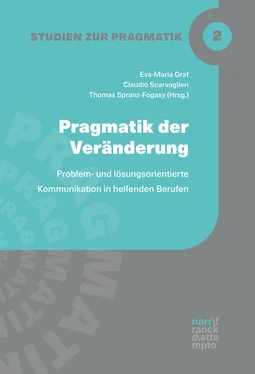Discourse analysis as a qualitative methodology used to investigate language use in context, has the tools to examine the process of client change. Thus it can be complementary to the main empirical psychotherapy research (Elliott 2012). This paper demonstrates how the clinical and discourse analytic perspectives can be combined in researching client change in two ways. Firstly, discourse analysis can evidence how the postulated mechanisms of change are actually accomplished in an interaction between the psychotherapist and the client. Secondly, based on the concept of common factors in psychotherapy (Lambert 2013a), the paper proposes common interactional strategies in psychotherapy fundamental to promoting client change.
Keywords:client change, discourse analysis, conversation analysis, common factors in psychotherapy, common interactional strategies
Siri Hustvedt, a well-known American novelist, in her collection of essays entitled “A woman looking at men looking at women. Essays on art, sex, and the mind” makes a reference to her own therapy and change she has experienced as a result of it:
For six years I have been in psychoanalytically based psychotherapy twice a week, and I have been changed by it. How this has happened remains mysterious. I could tell you a story now, one different from the story I arrived with on that first day, but the dynamics of how one story supplanted another, how talk, often repetitious, circling, speculative, even nonsensical, has achieved a shift in me, I couldn’t explain to you with any precision. I know this: I feel freer. I feel freer in my life and in my art, and those two are finally inseparable (Hustvedt 2016: 118).
The reference to the near impossibility of explicating change coming from such a sharp thinker and observer of human life as Hustvedt herself, already points to the complexity of capturing how client/patient1 change occurs. Still, Hustvedt talks about one story replacing the other as a testimony to the experienced change and thus feeling liberated. Yet the trajectory of getting from one life narrative to the other cannot be easily identified.
Watzlawick et al. (1974: 2) challenge the commonsensical opposition between change and persistence and put forward the following seemingly paradoxical assumption:
…persistence and change need to be considered together in spite of their apparently opposite nature. This is not an abstruse idea, but a specific instance of the general principle that all perception and thought is relative, operating by comparison and contrast.
Watzlawick et al.’s (1974) claim seems to be of vital relevance to the clients’ work in psychotherapy where their progression , although assumed to be incremental thus moving directly from point A to point Z, typically takes on a more uneven trajectory (see Lambert 2013b). Thus, as it is often claimed by clients, they take – in their view – one step forward toward improvement and then two steps backward. Furthermore, as Watzlawick et al. (1974) imply, whether something or somebody has in fact changed is very much contingent on the position from which the assessment is made.
Referring now to research on client change, Elliott (2012) – one of the key scholars researching client change – comments on the ‘rigidity’ of looking into, i.e. investigating, client change. He refers to the traditional “mode of understanding” in change process research (CPR) as realist relying on such metaphors as “‘change mechanisms’ (change process as machine) and ‘effective ingredients’ (a pharmaceutical metaphor)” (2012: 69). This in turn implies that there should be a recipe-like procedure to be followed if psychotherapists want to achieve a change of some sort in their clients despite, among others, clients bringing very different issues to therapy and numerous diverging approaches to doing psychotherapy.
The three views presented above point to a very complex picture of what client change is and what it might entail, its highly contingent character (Watzlawick et al. 1974), as well as the challenges in tracking it down both from the patient’s (Hustvedt 2016) as well as the researcher’s perspective (Elliott 2012).
In what follows the main trends in qualitative research on client change are presented, highlighting its methodological complexity. Next, the key tenets of conversation analysis as one of the approaches to discursive engagement with (therapeutic) data as well as the emerging conversation analytic research on client change are discussed. This is followed by the analytical section on the use of discourse analytic approaches in investigating client change. The focus of this section is on common factors in psychotherapy (Lambert 2013a) and common interactional strategies of co-construction and re-construction in promoting client change.
Problematizing client change and research on client change
Psychotherapy as a longitudinal process is geared to facilitate change that should ideally increase the clients’ contact with their problematic emotional experiences and parts of the self, and to increase their self-reflexive abilities (Rennie 1992; Norcross and Goldfried 2005; Leiman 2012; Voutilainen and Peräkylä forthcoming). The promise of change for the better is why clients embark on the therapeutic trajectory and from the clinical viewpoint client change is the motivation for all psychotherapies (Peräkylä 2013: 573; see also Carey et al. 2007). Yet how the psychological change occurs is still poorly understood (Higginson and Mansell 2008: 310). Elliott (2012: 70) refers to the process of change in psychotherapy as “complex and nuanced” (see also Lambert 2013b) and as Murray (2002) states, questions about the change process often focus on examining how psychotherapy is helpful.
Yet client change as a result of psychotherapy, although typically conceived of as bringing positive results and thus some sort of improvement in the client, can also be of negative character. The research shows that despite receiving validated and properly performed psychological treatments, some patients “experience deterioration and adverse events” (Bystedt et al. 2014: 319; Lambert 2013b). As reported by Bystedt et al. (2014), it is estimated that the so-called deterioration effect – referring to possible negative effects of psychological treatments (see Bergin 1966) – applies to between five per cent and ten per cent of all patients. Yet not enough is known about the so-called negative effects of psychotherapy (Bystedt et al. 2014). To reiterate, even though client change can be of positive and, in some cases, negative character, the extant research however, takes the default position on client change as positive.
A substantial body of research concentrates on identifying and examining the events in the psychotherapy process marked by clients and therapists as significant (e.g., Levitt et al. 2006; Carrey et al. 2007; Nilsson et al. 2007; Higginson and Mansell 2008). It is argued that these events comprise “the effective ingredients of change” (Viklund et al. 2010: 151). For example, Carrey and colleagues (2007) conducted interviews with 27 people at the end of their treatment and found that “many described change as occurring both as a gradual process and at an identifiable – and memorable – moment” (Carrey et al. 2007: 182; see also Higginson and Mansell 2008). Additionally, Carrey et al. (2007) identified six themes in the participants’ accounts of how change occurred. These are:
1 motivation and readiness,
2 perceived aspects of self,
3 tools and strategies,
4 learning,
5 interaction with the therapist,
6 and, the relief of talking.
It is worth noting that generally the participants of Carrey et al.’s (2007) study were unable to provide a specific definition of change (see Hustvedt’s (2016) comment above) and similarly to Levitt et al.’s (2006) findings, change was not attributed to concrete therapeutic approaches. Timulak (2007) presented a meta-analysis of factors that clients described as helpful in nine meta-categories:
Читать дальше












